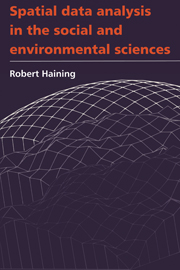Book contents
- Frontmatter
- Contents
- List of tables and displays
- Preface
- Acknowledgements
- PART A Introduction to issues in the analysis of spatially referenced data
- PART B Parametric models for spatial variation
- 3 Statistical models for spatial populations
- 4 Statistical analysis of spatial populations
- PART C Spatial data collection and preliminary analysis
- PART D Modelling spatial data
- Postscript
- Glossary
- References
- Index
4 - Statistical analysis of spatial populations
Published online by Cambridge University Press: 05 August 2012
- Frontmatter
- Contents
- List of tables and displays
- Preface
- Acknowledgements
- PART A Introduction to issues in the analysis of spatially referenced data
- PART B Parametric models for spatial variation
- 3 Statistical models for spatial populations
- 4 Statistical analysis of spatial populations
- PART C Spatial data collection and preliminary analysis
- PART D Modelling spatial data
- Postscript
- Glossary
- References
- Index
Summary
This chapter deals with inference procedures for the models of Chapter 3: model selection and parameter estimation; estimating confidence intervals; tests of hypotheses for choosing between alternative models; evaluating goodness of fit.
Maximum likelihood methods will be emphasised but not to the exclusion of alternatives. Small samples are often encountered in spatial data analysis, boundary effects are severe and the bilateral nature of many spatial interaction models give rise to awkward numerical problems. Maximum likelihood estimation is often very sensitive to correct model specification. For these reasons inference via either exact or approximate maximum likelihood may in some cases seem more trouble than it is worth and other methods lacking some of the apparently desirable properties of maximum likelihood estimators but computationally easier may be worth exploring. Further, most of these desirable properties are asymptotic. In the case of spatial data letting n (lattice size) increase to infinity has an ambiguous interpretation: does it imply more points within a fixed area or increasing the size of the study area? The former changes the nature of inter-site relationships, the latter may be inappropriate where the study area is of fixed size with a specified border. Below we refer to ‘large’ and ‘small’ sample situations. However, there is no natural continuity between the two as in the case of a time series with an increasing number of observations.
- Type
- Chapter
- Information
- Spatial Data Analysis in the Social and Environmental Sciences , pp. 118 - 168Publisher: Cambridge University PressPrint publication year: 1990

